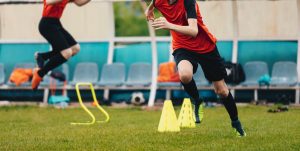Hamstring injuries can be painful and debilitating and often require a comprehensive rehabilitation program to restore normal function. At Twin Boro Physical Therapy, we offer a range of effective rehabilitation treatments for hamstring injuries, including therapeutic exercises and manual therapy techniques. Our experienced physical therapists will work closely with you to develop a personalized treatment plan to help you recover quickly and safely.
Common Causes of Hamstring Injury
 Hamstring injuries are a common type of musculoskeletal injury that affects the back of the thigh. The hamstring muscles, which run along the back of the thigh from the hip to the knee, are responsible for flexing the knee and extending the hip. Hamstring injuries can range from minor strains to complete tears. Common hamstring injuries include hamstring strains, avulsion injuries, and tendinopathy. Hamstring strains occur when the muscle is stretched beyond its capacity or experiences a sudden contraction, resulting in small tears in the muscle fibers. Avulsion injuries occur when the hamstring muscle pulls a piece of bone away from its attachment site. Tendinopathy is a degenerative condition that affects the tendon that attaches the hamstring muscle to the bone.
Hamstring injuries are a common type of musculoskeletal injury that affects the back of the thigh. The hamstring muscles, which run along the back of the thigh from the hip to the knee, are responsible for flexing the knee and extending the hip. Hamstring injuries can range from minor strains to complete tears. Common hamstring injuries include hamstring strains, avulsion injuries, and tendinopathy. Hamstring strains occur when the muscle is stretched beyond its capacity or experiences a sudden contraction, resulting in small tears in the muscle fibers. Avulsion injuries occur when the hamstring muscle pulls a piece of bone away from its attachment site. Tendinopathy is a degenerative condition that affects the tendon that attaches the hamstring muscle to the bone.
Manual Therapy for Hamstring Rehabilitation
Manual therapy techniques, such as soft tissue and joint mobilization, can help improve flexibility, increase range of motion, and reduce pain and inflammation in the hamstring muscles. Soft tissue mobilization involves using hands-on pressure and movement to stretch and loosen tight muscles and connective tissue. Joint mobilization involves gentle movement and manipulation of the joints to improve mobility and reduce pain.
Therapeutic Exercises for Hamstring Rehabilitation
Stretching and strengthening exercises are also essential to physical therapy rehabilitation for hamstring injuries. Specific exercises designed to strengthen and support the hamstring muscles, improve flexibility, and promote healing include:
- Hamstring curls – Lie face down on the floor, keep your legs straight, then bend your knee to bring your heel towards your buttocks. Keep your hips pressed to the ground throughout the exercise. Hold for 3-5 seconds, then slowly lower your leg back down. Repeat the same for the other leg.
- Standing hamstring stretch – Standing straight with your feet shoulder-width apart, keep your legs straight and bend forward at the hips, reaching down towards your toes. Hold the stretch for 10-15 seconds, feeling the stretch in your hamstrings, then slowly return to the starting position. Avoid bouncing or jerking movements during the stretch.
- Bridging – Lie on your back with your knees bent and feet flat on the floor. Slowly lift your hips towards the ceiling while keeping your feet and shoulders on the ground. Hold for a few seconds at the top, squeezing your glutes and hamstrings, then slowly lower your hips back down to the ground. Repeat for 10-15 repetitions.
In addition to these treatments, taking steps to prevent future hamstring injuries is essential. Preventative measures may include stretching before and after exercise, warming up gradually, and wearing proper footwear. A physical therapist can also provide education on proper body mechanics and injury prevention techniques to help reduce the risk of future injury.
Schedule a Consultation Today!
With a personalized treatment plan, a Twin Boro physical therapist will provide you with rehabilitation for your hamstring injury utilizing various physical therapy techniques and modalities. Contact Twin Boro Physical Therapy to schedule a consultation with one of our experienced physical therapists today. Call us at 732.554.0775 or visit the appointment request form at https://twinboro.com/schedule-appointment.html.

